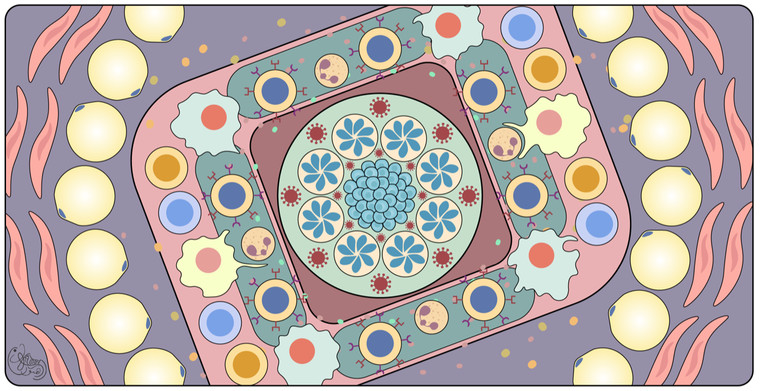Cachexia: How do immune responses contribute to weight loss?
Share
Cachexia is the name of a syndrome that is associated with numerous chronic diseases. It refers to weight loss induced by shrinkage of both fat reserves and muscle tissue. Although the occurrence of cachexia can have serious implications on patients’ health and survival, there are many aspects of this syndrome that are unknown and therapeutic options remain very limited. Scientists from Andreas Bergthaler's research group at CeMM emphasize the need for more research into cachexia in their recent publication in Nature Reviews Immunology. In order to counteract cachexia and numerous other diseases, a better understanding of the interplay between the immune system and metabolism is needed.
Cachexia occurs in patients with chronic infections such as HIV, tuberculosis and malaria, autoimmune diseases, and also frequently in those with advanced cancer. Affected patients lose body weight and strength, and reserves of fat and skeletal muscle mass are increasingly depleted. CeMM PI Andreas Bergthaler explains: "From an evolutionary point of view, cachexia could actually be part of the immune response. We start from the hypothesis that our body directs all energy towards the immune system to fight the actual disease. However, no positive effect of cachexia has been observed in diseases such as cancer. On the contrary, cachexia is one of the most frequent causes of death, and cancer patients are particularly affected. We see a difference here in cachexia during viral infection. “
CD8 killer cells trigger cachexia
In 2019, Bergthaler's research group was described a novel mechanism of how cachexia is initiated during viral infection. The team, led by first author Hatoon Baazim of Bergthaler's group, identified CD8 T killer cells as key molecular players in cachexia in chronic infections. Similar to cachexia associated with cancer, the weight loss could only be partially explained by reduced food intake and could not be prevented by dietary supplementation.
In addition, the study at that time showed that the viral infection led to a serious reorganization of the architecture of fat tissue. Despite these findings, many questions remain still to be answered. "We need to understand how cachexia is driven, what factors play a role. In this regard, the comparison between infection-associated and cancer-associated cachexia offers a valuable opportunity to delineate the mechanisms behind it," explains study author Hatoon Baazim, "This review article not only addresses the current state of research, but also highlights key questions that should be addressed in order to understand and effectively fight cachexia."
More exchange between disciplines
A wide variety of diseases can cause the same concomitant symptoms that are characteristic of cachexia. It is clear that the interplay between the immune system and metabolism plays a central role. Despite the frequency of cachexia, little is known about the molecular processes that initiate it or the downstream consequences of cachexia on the immune response to the underlying disease. This lack of knowledge explains why there are still no effective therapies for cachexia, which takes away valuable life and therapy time from cancer patients. In addition, it also reduces the quality of life of those affected, causing loss of appetite and strength as well as fatigue. "We now understand the function of many messenger molecules that can promote or inhibit cachexia - depending on the disease context. We are also starting to unveil the importance of immune cells in cachexia. Importantly, all these messenger molecules, the immune cells and the affected tissues co-exist within the same system and are continuously influencing each other." explains Bergthaler. This complexity is highlighted by first-author Hatoon Baazim: “During cachexia, the fat tissue and muscles shrink and release a lot of the energy which was stored as fat and proteins. Their fate and the reason for why these processes are triggered during chronic diseases is poorly understood, although the field of immunometabolism has already mapped out ways in which these molecules could influence our immune system.”. This review aims to shed more light on the clinically highly relevant but ill-understood disease of cachexia by encouraging new interdisciplinary cooperations at the interfaces of immunology, oncology, infection research, pathophysiology and metabolic research. The integrated knowledge gained would not only make cachexia easier to understand and treat, but also enable to answer fundamental questions about the immune system.
The article "The interplay of immunology and cachexia in infection and cancer" was published in Nature Reviews Immunology on 4 October 2021. DOI: 10.1038/s41577-021-00624-w.

